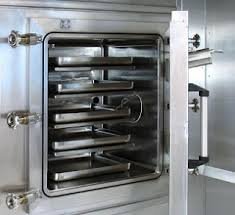The Functionality of Tray Dryers in Drying Processes

A Tray Dryer is a type of drying equipment used to remove moisture from materials, typically in industries such as pharmaceuticals, food processing, and chemicals. The principle behind a tray dryer revolves around the efficient transfer of heat and mass to remove moisture from the materials placed on trays within a drying chamber.
1. Basic Structure of a Tray Dryer:
A tray dryer typically consists of:
-
Drying Chamber: A sealed compartment that houses multiple trays.
-
Trays: Flat surfaces on which the material (such as powders, granules, or food) is spread out for drying.
-
Air Circulation System: Fans or blowers that circulate heated air throughout the chamber.
-
Heating Element: Provides the necessary heat to dry the materials, which could be electric, steam, or hot water-based.
-
Exhaust System: Removes the moisture-laden air and ensures a continuous drying process.
2. Working Principle of Tray Dryer:
The drying process in a tray dryer follows the basic principle of heat transfer and mass transfer:
Heat Transfer:
The heat is transferred from the heating element to the air inside the drying chamber. This heat is then transferred to the material being dried via conduction, convection, or radiation.
-
Conduction: Heat is transferred directly from the heated air to the surface of the material in contact with the tray.
-
Convection: The heated air circulates around the material, transferring heat to its surface and removing moisture.
-
Radiation: In some cases, radiation may play a role if the heat is directly applied to the material.
Mass Transfer:
As heat is transferred to the material, the moisture within the material evaporates. The moisture vapor then diffuses from the material’s surface into the air. The exhaust system removes this moist air from the chamber, maintaining the drying process’s efficiency.
-
Initially, moisture at the material’s surface evaporates quickly.
-
Gradually, as the moisture from the surface decreases, the evaporation slows down, and the drying process continues until the material reaches the desired moisture content.
Air Circulation:
-
The fans inside the tray dryer ensure the continuous flow of warm air over the material, improving the efficiency of the drying process. The circulation of air ensures uniform drying by preventing hot spots and ensuring even exposure of all material to the heated air.
-
The exhaust system is essential because it removes the moist air and prevents the humidity levels inside the chamber from rising, which could slow down the drying process.
3. Drying Stages:
There are typically two stages in the drying process:
-
Constant Rate Period: This is when the material is drying at a constant rate. The rate of evaporation is fast because the material’s surface is still fully saturated with moisture, and the heat supply is constant. During this phase, moisture is being removed from the surface.
-
Falling Rate Period: After the surface moisture is removed, the rate of evaporation slows down because the moisture has to diffuse from the deeper parts of the material. The drying process is slower, and the material is gradually reaching its final dry state.
4. Factors Affecting Tray Dryer Efficiency:
-
Air Temperature: Higher temperatures increase the rate of evaporation. However, the temperature should not be too high as it might degrade the material.
-
Airflow: Proper airflow helps ensure that moisture is carried away efficiently and that heat is uniformly distributed.
-
Humidity: Lower humidity levels in the air enhance the drying process, as the moisture from the material can evaporate more easily.
-
Material Thickness and Composition: Thicker materials may take longer to dry, and materials with higher moisture content will also take more time.
-
Tray Arrangement: Proper spacing and arrangement of trays ensure better air circulation around the material, leading to uniform drying.
5. Advantages of Tray Dryers:
-
Uniform Drying: The air circulation ensures uniform drying, reducing the risk of over-drying or under-drying certain parts of the material.
-
Gentle Drying Process: Tray dryers are suitable for materials that are sensitive to heat or temperature, as they provide a gentle drying process.
-
Energy Efficiency: Tray dryers can be energy-efficient if operated under optimal conditions, using heat recovery systems.
-
Low Maintenance: Compared to other drying equipment, tray dryers generally require low maintenance.
6. Applications of Tray Dryers:
Tray dryers are commonly used in industries where a precise drying process is needed:
-
Pharmaceutical Industry: To dry pharmaceutical powders, granules, and herbs.
-
Food Industry: Drying fruits, vegetables, meat, herbs, etc.
-
Chemical Industry: Drying chemical powders, catalysts, or other solid materials.
-
Laboratories: For drying small batches of materials or products.
Conclusion:
The principle of a tray dryer is based on effective heat transfer and air circulation to remove moisture from the material. The drying process is carefully controlled through temperature, airflow, and humidity to achieve the desired product quality. Tray dryers are widely used in industries where batch processing and controlled drying are essential.
🎓 Discover one of the best Pharmaceutical Production courses available — click below to explore the course that’s shaping future Production skills.
#DrugDevelopment, #DrugSafety, #DryingProcess, #DryingTechnology, #GMPCompliance, #HeatTransfer, #IndustrialDrying, #MoistureRemoval, #PharmaceuticalDrying, #PharmaceuticalIndustry, #TrayDryer
Posted onMay 5, 2025

